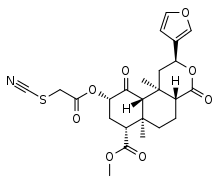RB-64
RB-64 or 22-thiocyanatosalvinorin A is a semi-synthetic salvinorin derivative and a κ-opioid receptor (KOR) agonist which is used in scientific research. Its most remarkable property is its biased activity in signal transduction in favour of G protein versus β-arrestin-2, a phenomenon which is called functional selectivity or biased agonism. RB-64 has a bias factor of 96 and is analgesic with fewer of the prototypical side-effects associated with unbiased KOR agonists. The analgesia-like effect is long-lasting. Compared with unbiased agonists RB-64 evokes considerably less receptor internalisation.[1]
 | |
| Clinical data | |
|---|---|
| ATC code |
|
| Legal status | |
| Legal status |
|
| Identifiers | |
IUPAC name
| |
| PubChem CID | |
| ChemSpider | |
| ChEMBL | |
| Chemical and physical data | |
| Formula | C24H27NO8S |
| Molar mass | 489.54 g/mol g·mol−1 |
| 3D model (JSmol) | |
SMILES
| |
InChI
| |
References
- White K, Robinson JE, Zhu H, et al. (January 2015). "The G Protein–Biased κ-Opioid Receptor Agonist RB-64 Is Analgesic with a Unique Spectrum of Activities In Vivo". Journal of Pharmacology and Experimental Therapeutics. 352 (1): 98–109. doi:10.1124/jpet.114.216820. PMC 4279099. PMID 25320048.
Further reading
- Yan F, Bikbulatov RV, Mocanu V, et al. (July 2009). "Structure-Based Design, Synthesis, and Biochemical and Pharmacological Characterization of Novel Salvinorin A Analogues as Active State Probes of the κ-Opioid Receptor". Biochemistry. 48 (29): 6898–908. doi:10.1021/bi900605n. PMC 2752672. PMID 19555087.
- White KL, Scopton AP, Rives ML, et al. (January 2014). "Identification of Novel Functionally Selective κ-Opioid Receptor Scaffolds". Molecular Pharmacology. 85 (1): 83–90. doi:10.1124/mol.113.089649. PMC 3868907. PMID 24113749.
This article is issued from
Wikipedia.
The text is licensed under Creative
Commons - Attribution - Sharealike.
Additional terms may apply for the media files.